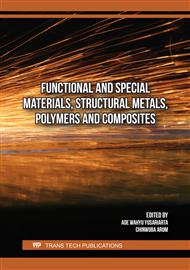[1]
D. K. Singh, Fundamentals of Manufacturing Engineering Concepts and Applications, 3rd edition, Springer Nature Singapore Pte Ltd.
Google Scholar
[2]
Er. R.K. Rajput, A textbook of Manufacturing Technology (Manufacturing Processses), Laxmi publications (P) LTD (2018).
Google Scholar
[3]
R. Butola, P. Ali, V. Khanna, Effect on Surface Properties of mild steel during dry turning & wet turning on lathe. Materials Today: Proceedings 4 (2017) 7892-7902.
DOI: 10.1016/j.matpr.2017.07.125
Google Scholar
[4]
A. A. Tomal, A. B. Rashid, A. S. Sami, S. M. Shahriar, E. Sultana, Improvement of Machinability of Hardened Steel in Turning Operation Using Cryogenically Treated Cutting Tool. Materials Science and Engineering 1305 (2024) 012017.
DOI: 10.1088/1757-899x/1305/1/012017
Google Scholar
[5]
H. Yanda, J. AGhani, M. N. Rodzi, K. Othman, C. C. Haron, Optimization of material removal rate, surface roughness and tool life on conventional dry turning of FCD700. International Journal of Mechanical and Materials Engineering 5 (2010) 182-190.
Google Scholar
[6]
T. Panneerselvam, T. K. Kandavel, P. Kishore, Experimental investigation on cutting tool performance of newly synthesized P/M alloy steel under turning operation. Arabian Journal for Science and Engineering 44 (2019) 5801-5809.
DOI: 10.1007/s13369-019-03763-4
Google Scholar
[7]
S. K. Pradhan, S. K. Saini, Multi-objective optimization of CNC turning machining parameters. Advanced Materials Research 1016 (2014) 172-176.
DOI: 10.4028/www.scientific.net/amr.1016.172
Google Scholar
[8]
S. K. Saini, S. K. Pradhan, Optimization of machining parameters for CNC turning of different materials. Applied Mechanics and Materials 592 (2014) 605-609.
DOI: 10.4028/www.scientific.net/amm.592-594.605
Google Scholar
[9]
O. G., Ehibor, B. N. Aliemeke, Optimization of process parameters of surface roughness and material removal rate in orthogonal turning of AISI 1045 Carbon Steel using Taguchi technique. Optimization 10 (2021).
DOI: 10.7176/iel/11-1-03
Google Scholar
[10]
A. G. Tefera, D. K. Sinha, G. Gupta, Experimental investigation and optimization of cutting parameters during dry turning process of copper alloy. Journal of Engineering and Applied Science 70 (2023) 145.
DOI: 10.1186/s44147-023-00314-5
Google Scholar
[11]
S. Teja, T. Sathish, Investigating the Material Removal Rate and Surface Finish by estimating the machinability performance of Novel KTRN Coated HSS Tool for CNC Turning of HSS alloy (EN24) and compare with Uncoated HSS Tool. Journal of Survey in Fisheries Sciences 10 (2023) 2106-2122.
DOI: 10.47750/pnr.2022.13.s04.038
Google Scholar
[12]
A. B. Mahrous, A study of surface roughness and material removal rate for optimal parametric combination in turning of GFRP composites. ERJ. Engineering Research Journal 46 (2023) 213-223.
DOI: 10.21608/erjm.2023.185670.1242
Google Scholar
[13]
S. K. Saini and P. Kumar, CNC turning process parameters optimization for stainless steel. Applications of Advanced Computing in Systems. Algorithms for Intelligent Systems (2021) 59-64.
DOI: 10.1007/978-981-33-4862-2_6
Google Scholar
[14]
T. M. El-Hossainy, AM. El-Tamimi, Surface Roughness Evaluation Using Factorial Design in Turning Operation. Journal of King Saud University-Engineering Sciences 22 (2010) 153-162.
DOI: 10.1016/s1018-3639(18)30502-6
Google Scholar
[15]
S. K. Sahu, P. C. Mishra, K. Orra, A. K. Sahoo, Performance assessment in hard turning of AISI 1015 steel under spray impingement cooling and dry environment. Proceedings of the Institution of Mechanical Engineers, Part B: Journal of Engineering Manufacture 229 (2015) 251-265.
DOI: 10.1177/0954405414528165
Google Scholar
[16]
G. Eid Ramadan, Optimization of Cutting Parameters on Surface Roughness And Material Removal Rate Using Response Surface Methodology In Turning Process Of Al-7075 With High Speed Steel. Engineering Research Journal-Faculty of Engineering (Shoubra) 42 (2019) 15-22.
DOI: 10.21608/erjsh.2019.242407
Google Scholar
[17]
S. C. Borse, Optimization of turning process parameter in dry turning of SAE52100 steel. Int J Mech Eng Technol 5 (2014) 01-8.
Google Scholar
[18]
S. K. Saini Optimization of MRR for CNC Turning of Hard Steel, International Journal of Scientific Research in Science, Engineering and Technology 9 (2022) 128-133.
Google Scholar
[19]
M. Nooruddin, U. V. Hambire, Analysis of Process Parameters for Material Removal Rate During Dry Turning of FG 260 Grey Cast Iron. International Journal of Engineering Research & Technology 4 (2015) 605-610.
DOI: 10.17577/ijertv4is040885
Google Scholar


